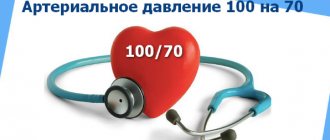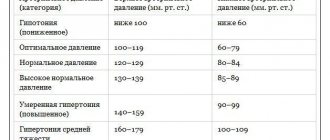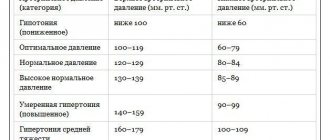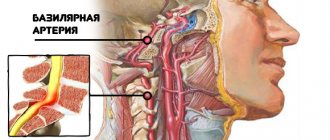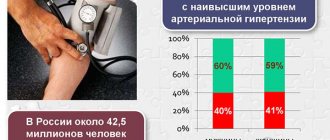The generally accepted norm for blood pressure is a tonometer reading of 120/80, but deviations in both directions of these numbers are considered acceptable if they are isolated and do not accompany a deterioration in a person’s well-being. Regular pressure surges in one direction or another, if they occur at least several times a month, are considered hypertension or hypotension. But what if the device recorded a pressure of 110 over 90? What to do, whether you need to see a doctor right away and whether this condition is dangerous - today we will talk about this in detail.
Hypotension - features of the disease
Arterial hypotension (hypotension) – a decrease in blood pressure by 20% or more. Normally this figure is 120∕80 mm. rt. Art., then hypotension is diagnosed when systolic pressure drops to 90, and diastolic pressure drops to 60 mm. rt. Art. The disease can be congenital or acquired, develop as an independent disease or accompany other pathologies.
Causes of hypotension
In most patients, hypotension develops with a decrease in vascular tone. Normally, their walls should expand and contract due to the muscle layer, in response to an increase or decrease in fluid in the bloodstream. However, with some diseases, muscles become weak and unable to adapt to changes. A decrease in circulating blood is normally accompanied by a narrowing of the lumen of blood vessels so that it flows with sufficient force to organs and tissues. With hypotension, a decrease in blood and a slowdown in its movement lead to insufficient blood supply to the head and limbs, and then to other organs.
Hypotension often occurs in a chronic form. During its course, there is an alternation of periods of long-term remission and exacerbation. Seizures can be triggered by the following factors:
- chronic heart failure;
- neuroses, stress, insomnia, lack of rest during intense work;
- history of traumatic brain injury;
- a sharp decrease in the total amount of blood in the vessels (burns, injuries, blood loss);
- physiological hypotension when the body adapts to being high in the mountains, as well as in athletes with well-trained heart muscle and a large volume of circulating blood.
With low blood pressure, headaches are the result of insufficient blood supply to the cells and tissues of the brain. Weakness of the vascular walls and other factors lead to permanent or temporary ischemia. This is a dangerous disorder in which nerve tissue lacks oxygen and nutrients. The result is headaches and other characteristic symptoms. In addition, prolonged cerebral ischemia is the main predisposing factor to the development of stroke.
Symptoms of low blood pressure
Acute or chronic hypotension is a dangerous disease in which organs and tissues are subject to ischemia. Symptoms are associated with these processes and therefore pose a danger to the body. They can be triggered by stress; they also often appear in stuffy rooms and with a lack of oxygen. A typical complex may include the following manifestations:
- general weakness, lethargy, fatigue;
- nausea and dizziness;
- headache;
- pallor of the skin and mucous membranes.
If your blood pressure drops sharply and you have a headache, you may faint. This often occurs in poorly ventilated areas at high air temperatures. Symptoms quickly appear and increase, the patient experiences tinnitus, deterioration of hearing and vision. It is important to provide first aid in a timely manner in case of an acute attack of hypotension.
Symptoms
Normal upper pressure and elevated lower pressure often go unnoticed at the initial stage. Even if a high diastole was once recorded during a routine examination by a cardiologist, a small number of patients pay attention to this and undergo the examination. Only in the second and third stages, during surges in lower pressure, does a person begin to experience pronounced symptoms of hypertension:
- attack of nausea with the urge to vomit;
- high pulse - 100 beats per minute;
- dizziness and nosebleeds;
- release of cold sticky sweat;
- noise and ringing in the ears;
- feelings of fear and anxiety;
- dyspnea;
- a rush of blood to the face, a feeling that the cheeks are burning;
- feeling of discomfort and pain behind the sternum.
When the lower pressure rises to critical levels, a person gets a headache, his vision may become blurred, and the picture before his eyes becomes double. Another characteristic symptom is a lack of coordination in space, when dizziness leads to fainting.
Headaches with low blood pressure
Headaches with low blood pressure can vary in nature and intensity. They can increase quickly if pressure readings decrease sharply, or accompany the patient constantly. The following features are characteristic of pain due to hypotension:
- lack of precise localization - discomfort spreads to the entire surface of the head;
- additional symptoms: nausea and dizziness;
- chronic course, with alternating periods of relief and exacerbation.
If your blood pressure is constantly low and your head hurts, this indicator must be maintained with medication. With prolonged use, migraine may develop. This is an acute headache that does not go away even after normalization of blood pressure and significantly affects performance.
Diagnosis of headaches due to hypotension
It is important to determine the exact reason why your blood pressure drops and your headache occurs. It is not difficult to measure this indicator, including at home. It is enough to use a tonometer and determine that the pressure has been reduced to 90/60 mm. rt. Art. and less. However, doctors at the Clinical Brain Institute recommend undergoing a full examination if hypotension occurs frequently and is accompanied by headaches. To determine the cause of this disease, additional techniques may be required:
- general and biochemical blood tests, as well as determination of the rate of blood clotting;
- Dopplerography - ultrasound of blood vessels with the addition of a contrast agent, informative for diagnosing blood flow in the neck and head;
- MRI of the cervical spine - allows you to determine osteochondrosis, intervertebral hernias and other pathologies that impair blood circulation;
- electrocardiography, ultrasound of the heart - prescribed for suspected heart failure and other diseases.
At the Clinical Brain Institute, you can undergo comprehensive diagnostics, which will help determine the cause of chronic hypotension. Our main advantages are the availability of precise and modern equipment, high qualifications and many years of experience of our specialists. After examination and diagnosis, the doctor will select a treatment regimen to relieve attacks of hypotension and reduce the manifestation of headaches.
Treatment methods
If the patient has low blood pressure, a headache, weakness and dizziness, it is necessary to restore normal blood flow through the vessels as quickly as possible. Then it is important to consult a doctor to select medications for a course of treatment. The regimen is prescribed individually, depending on general health, blood pressure readings, accurate diagnosis and concomitant diseases.
First aid
If your blood pressure drops, your head hurts, or your health suddenly deteriorates, this indicates an insufficient supply of oxygen to the brain cells. It is important to restore your blood pressure before seeing a doctor. To do this, doctors recommend using several methods:
- take caffeine - this substance has a vasoconstrictor effect and is found in coffee and strong tea;
- provide access to oxygen, ventilate the room or go outside;
- take a sitting position and lower your head down - this normalizes blood flow to the brain;
- Unbutton the collar, loosen the cuffs on the sleeves.
After these manipulations, the pressure will return to normal, but the attack may recur. It is also important to notice its onset in time. If your health has sharply deteriorated, your head hurts, dark circles appear before your eyes, you must immediately inform others about the problem and ask for help.
Drug treatment
For the comprehensive treatment of headaches due to hypotension, a course of medications is prescribed. Some of them are designed to quickly narrow blood vessels and restore blood flow and are used to relieve attacks. The doctor will also recommend medications for a course of treatment. The regimen may include the following drugs:
- drugs that stimulate an increase in blood pressure, including those based on caffeine (Pyramein, Caffetamine);
- medications to improve blood supply to brain tissue and to prevent stroke (Glycine, Tanakan);
- herbal preparations for raising blood pressure and normalizing the functioning of the nervous system (tincture of Eleutherococcus).
The effectiveness of treatment must be constantly monitored by measuring blood pressure. To do this, it is enough to use a tonometer once every few days. Monitoring indicators too frequently leads to disruption of the nervous system and neuroses, which can provoke additional attacks of hypotension. Doctors at the Clinical Institute of the Brain will select a suitable treatment regimen, which will include only useful and necessary drugs, without unnecessary prescriptions and procedures. However, it is important to follow all instructions and take medications as scheduled.
Forecast
{banner_banstat10}
It is difficult to say exactly what a patient can expect. A group of factors is taken into account:
- Age.
- Floor.
- The nature of professional activity.
- History of somatic pathologies (concomitant).
- Duration of the condition.
- His reaction to the treatment.
- Degree of physical activity.
- Family history.
- Blood pressure level in general, over a longer period of time.
- Main diagnosis.
In general, an indicator of 30 mmHg against a background of blood pressure of 110 over 80 has good prospects in terms of preserving life. This is not yet a critical level, although it is an alarming signal. If treatment is prescribed, there is a high probability of full recovery.
A blood pressure of 110 over 80 in an adult is not normal due to low PP levels. This is an indication of pathology; natural factors do not lead to a decrease in the indicator. Diagnostics will put an end to the issue. Treatment methods and prognosis are determined after.
Prevention methods
Low blood pressure can be either congenital or acquired. In young people, hypotension is often caused by stress, poor diet, and vitamin deficiency (especially A, C and E). In order to maintain the health of the cardiovascular system and prevent most dangerous diseases, it is enough to follow a few simple advice from doctors:
- spend less time in stuffy rooms - this leads to oxygen starvation of cells and tissues;
- ensure proper rest - daily sleep of at least 7-8 hours is important for restoring the body after a working day;
- regularly engage in sports at an amateur level - the muscular layer of the vascular walls and myocardium also need constant training;
- eat well, get enough vitamins;
- Every morning, do a little exercise to improve blood circulation before getting up - this will help prepare the cardiovascular system for the start of the day and avoid sudden stress.
Often a headache with low blood pressure is a dangerous symptom. Doctors at the Clinical Institute of the Brain recommend not to self-medicate, since hypotension is often chronic and can progress. It is important to undergo an examination in time and select medications that will strengthen blood vessels, improve blood circulation, relieve headaches and prevent the dangerous consequences of the disease.
Are such numbers dangerous?
Yes, these indicators pose a threat to life and health. Close to them, 110 to 85, 105 to 75, when the pulse pressure is identical, have the same forecasts. But the others, 105 to 80 as an example, are much more serious, since the PD is even lower.
What are the possible consequences:
- Heart failure. In the event of urgent resuscitation, there is still a chance to return the patient.
- Heart attack. Acute death of muscle organ structures.
- Stroke. Brain nutritional disorder. Necrosis of nerve tissue leads to severe neurological deficits. The prospects for recovery depend on the extent of the damage.
- Shock resulting from a sharp drop in blood pressure and blood output.
- Impaired cognitive and mnestic functions as a result of insufficient supply to the brain. May result in vascular dementia.
- A general decrease in the quality of life, a decrease in working capacity and other important biological and social indicators.
However, the risks are at an average level. This is not a critical condition yet, but it is not the first phase either. Most likely, the pathological process is already underway, and it will be noticeable in instrumental diagnostics and even to the patient himself. If you listen to your own body.

